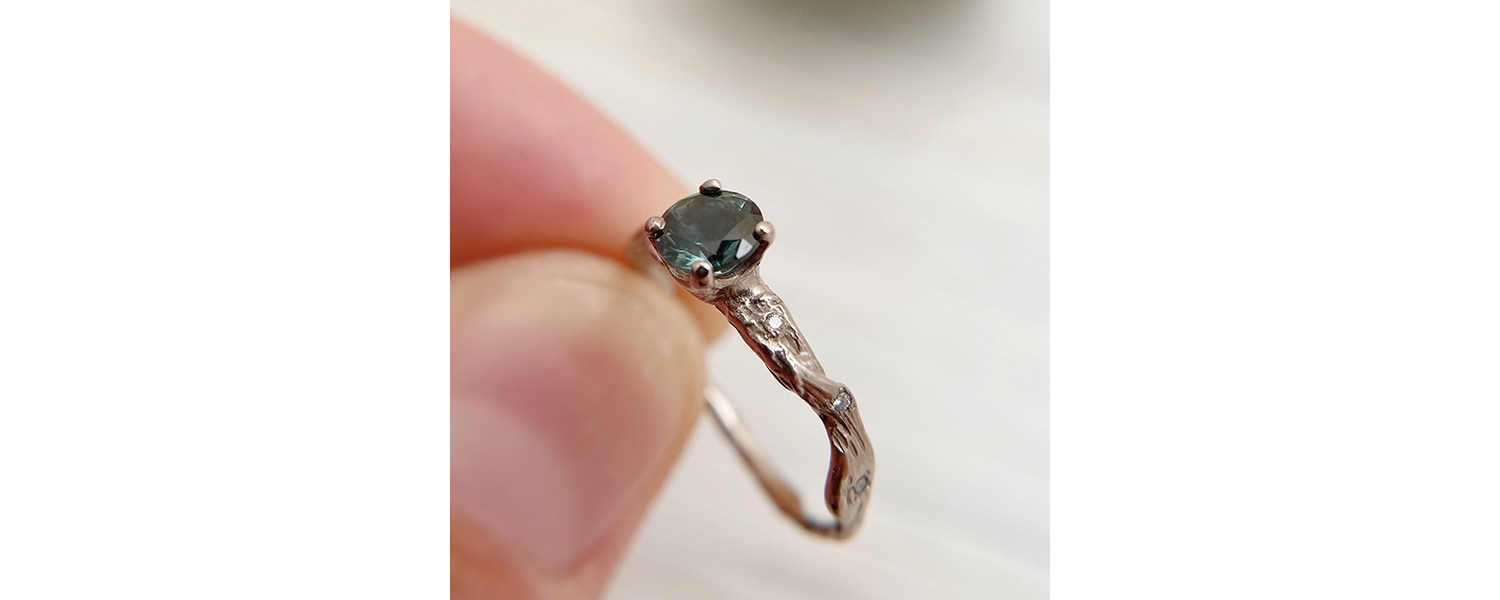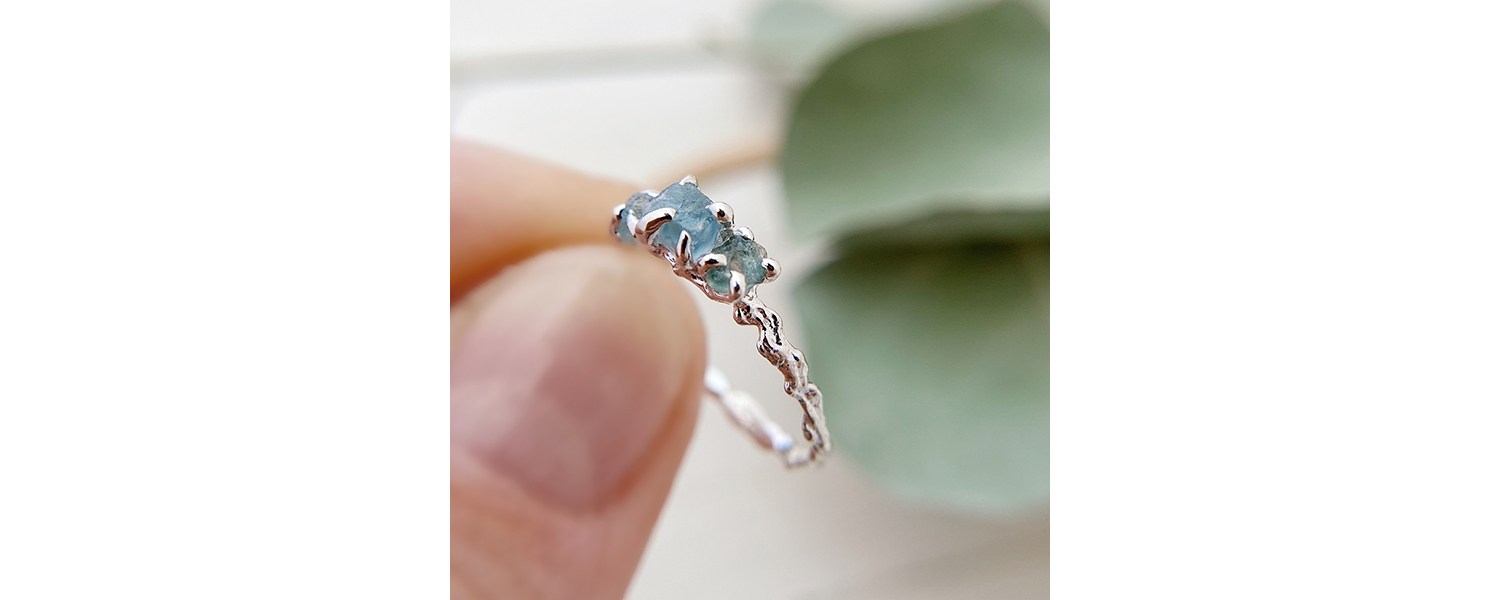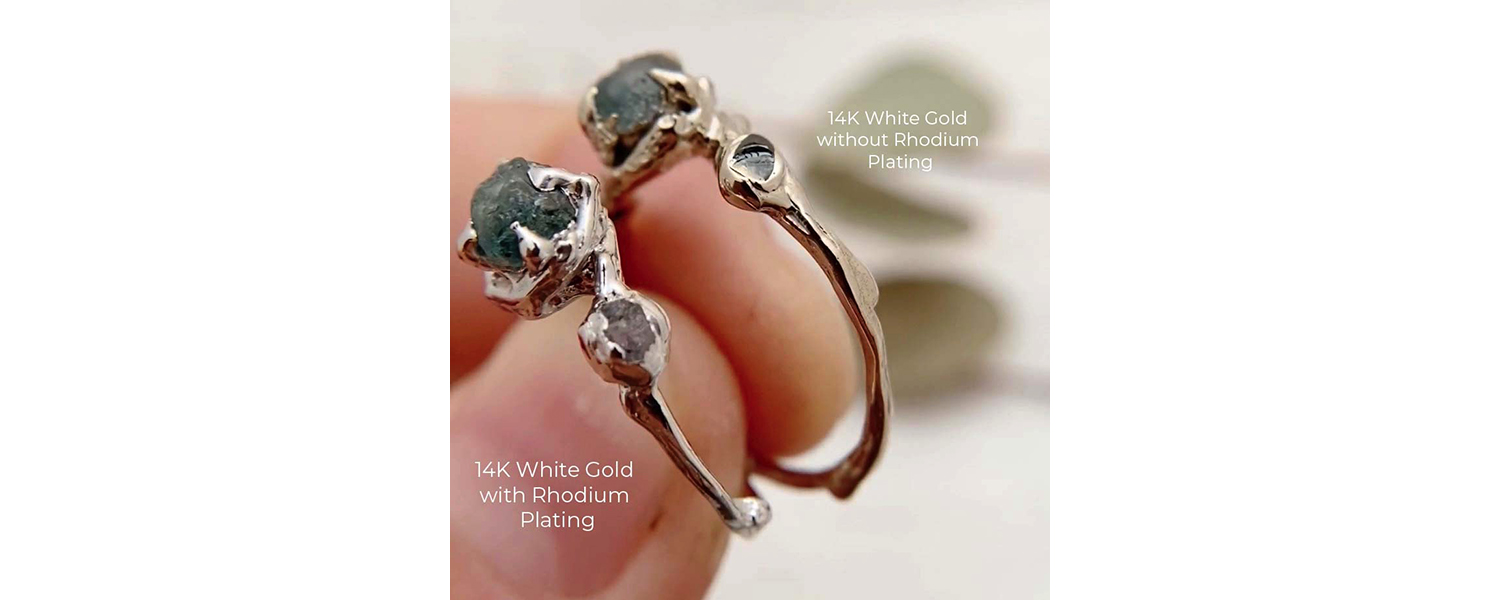
GOLD CHOICE COMPARISON
Our natural designs are handcrafted in five main materials: 14K gold, 18K gold, platinum, palladium, and sterling silver. Each of these 100% recycled metals have a unique composition of elements that are responsible for their specific properties such as hardness, luster, and color.
18K YELLOW GOLD

Composition: 75.50% Gold, 15% Silver, 9.50% Copper
Hardness: 2.75 (Moh's Scale) Advantages: Rich yellow-gold color, Hypoallergenic
Disadvantages: Prone to scratches/dents
18K gold is nickel-free and less likely to cause skin irritation than other golds. It has a brighter yellow-gold color than 14K gold, but the higher purity of the gold makes it soft and susceptible to scratches, dents, and cracks during rough activities. One of the oldest alloys for engagement rings and fine jewelry, 18K yellow gold is a traditional wedding choice.
18K PALLADIUM WHITE GOLD

Composition: 75.50% Gold, 0.75% Silver, 14.5% Copper, 3.5% Zinc, 5.75% Palladium
Hardness: 2.75 (Moh's Scale) Advantages: Less tarnishing, Hypoallergenic
Disadvantages: Prone to scratches/dents, Warm Grey Hue
18K white gold is alloyed with palladium that gives the gold a clean white color without the need for plating. The purer gold content means there will be less oxidation and the white color will be brighter for longer than 14K gold. 18K white gold with palladium has a warm grey hue that gives the ring an antique look. Its higher gold percentage makes it softer and more prone to scratches than 14K.
18K ROSE GOLD

Composition: 75.50% Gold, 1% Silver, 22.25% Copper, 1.25% Zinc
Hardness: 2.75 (Moh's Scale) Advantages: Pale pink color, Hypoallergenic
Disadvantages: Prone to scratches/dents
Due to a lower copper percentage, 18K rose gold is lighter than 14K gold and has a less saturated orangey appearance, making it looks almost champagne. 18K rose gold is relatively soft and can be scratched and scuffed more easily than 14K gold.
14K YELLOW GOLD

Composition: 58.50% Gold, 5% Silver, 31.25% Copper, 5.25% Zinc
Hardness: 3-4 (Moh's Scale) Advantages: Durable, Hypoallergenic Disadvantages: Fainter gold color
14K gold accounts for roughly 90% of all gold engagement and wedding rings because of its good durability and bright light gold color. Its less saturated gold color is perfect if you are concerned about an overly-yellow appearance.
14K WHITE GOLD

Composition: 58.50% Gold, 23% Silver, 9% Zinc, 9.50% Nickel
Hardness: 3-4 (Moh's Scale) Advantages: Durable Disadvantages: Yellowish undertone, Possible skin irritation
14K white gold is the most durable out of the 14K golds because of its high percentage of nickel, however, this quality also gives it a higher chance of skin irritation. If you are allergic to nickel, opt for a nickel-free choice - 14K yellow gold, 14K rose gold, all of the 18K golds and platinum.
14K WHITE GOLD WITH RHODIUM PLATING

Composition: 58.50% Gold, 23% Silver, 9% Zinc, 9.50% Nickel
Hardness: 3-4 (Moh's Scale) Advantages: Durable Disadvantages: Re-plating Rhodium, Possible skin irritation.
14K white gold rings are plated in Rhodium in order to increase their whiteness, shine and durability. With time, this plating wears off and the gold undertones come through. Wear rate for plating depends on your individual skin chemistry as well as cosmetics and chemicals that come in contact with the ring, but it generally has to be redone every 1-3 years to maintain a bright white shine. This process is inexpensive and can be done by most local jewelers. Rhodium plating shields your skin from the white gold nickel content, but due to wear, it's still not recommended for those with nickel allergies.
14K ROSE GOLD

Composition: 58.50% gold, 1% silver, 39.50% copper, 1% Zinc
Hardness: 3-4 (Moh's Scale) Advantages: Durable, Hypoallergenic Disadvantages: Darker pink than 18K rose gold
14K rose gold is a deeper pink than 18K rose gold with more orangey undertones. It is fairly durable and does not contain any skin-irritating nickel. Rose gold does not tarnish but it may get slightly darker over the years which is a normal process and should be expected.
PLATINUM

Composition: 95% Platinum, 5% Ruthenium
Hardness: 4.5 (Moh's Scale) Advantages: Durable, Hypoallergenic, Non-Tarnish Disadvantages: Expensive
Platinum is known for its high density, making it heavy and better equipped for holding engravings and shape. It also maintains its light grey color indefinitely and is less likely to be damaged by household chemicals than other metals. Platinum is great for highlighting diamonds and showing off the true color of other gemstones. It's a very popular and traditional choice for engagement rings.
PALLADIUM
Composition: 95% Palladium, 5% Ruthenium
Hardness: 5.75 (Moh's Scale) Advantages: Durable, Hypoallergenic, Non-Tarnish Disadvantages: Expensive
Palladium is more affordable and a slightly deeper white than platinum, while still being very durable due to its higher hardness rating. It also has a natural white color which means it will not tarnish and will remain a bright white over the years. Palladium has become a very popular choice for men's wedding rings due to its more steely metallic color. Any of our women's rings are also available in palladium upon request.
STERLING SILVER

Composition: 92.5% Silver, 7.5% Copper
Hardness: 2.5 (Moh's Scale) Advantages: Affordable, Hypoallergenic Disadvantages: Very prone to scratches/dents
Sterling silver is very soft, making it ill equipped for setting diamonds and other hard stones. It is likely to bend slightly over time to align with the curvature of your finger and does not hold texture well. Silver tarnishes easily when unworn and exposed to oxygen. Silver may require more upkeep and repairs throughout the years.
14K YELLOW GOLD VS. 18K YELLOW GOLD

A side by side comparison of 14K versus 18K yellow gold. 14K gold is 1 point on Moh's hardness scale higher than 18K gold, making it more durable and less prone to scuffs and dents. However, as you can see in the photo, the colors differ and depending on your personal preference, either gold may be best for you. Both karats are very common and appropriate for everyday wear.
14K WHITE GOLD WITH VS. WITHOUT RHODIUM PLATING

A side by side comparison of 14K white gold with and without rhodium plating. Rhodium plating gives the gold a brighter white color (as you can see on the left), however this plating wears off and needs to be replaced every few years.



To learn about the differences in care for each of these materials, please visit our Cleaning & Care Guide.

